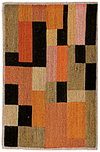Exam 4 Flashcards

Kazimir Malevich, Black Square, Blue Triangle, 1915, oil on canvas, Russia
- Not perfect, invites you to look close and think about the materials by which it is made

Varvara Stepanova, Design for a woman’s suit, 1924, ink on paper, Soviet Union
- Designed women’s clothing taking geometric and abstract form, but has a use
- Married to Rodchenko, CONSTRUCTIVIST POWER COUPLE

Vladimir Tatlin, Monument to the Third International, 1919-20, iron and mixed media, Soviet Union
- model was supposed to be a meeting place for communists
- was supposed to rotate
- rival other buildings, like eiffel tower
- actually never built
- reflected ideals of constructivism
- transparency of government

Piet Mondrian, Composition with Red, Blue, Black, Yellow, and Gray, 1921, oil on canvas, Dutch
- Signature style
- No longer a grid, more variations
- This is where he hits his stride and begins to establish is style
- Systematize and codify the world
- Not perfect surfaces, not about mechanism and making everything cold and precise, but in terms of balance and playing with balance

Gerrit Rietveld, Armchair, 1918, wood, Dutch
- Balance and stuff in 3d

Hugo Ball in costume performing his sound poem “Karawane” at the Cabaret Voltaire in Zurich, Switzerland, 1916

Sophie Taeuber and Jean Arp, Pathetic Symmetry, 1916-1917, cross stitch, Switzerland
- two artists working together on geometric embroidery textile pieces
- embroidery was not considered fine art before- so this made people look at what was considered women’s work
- their work didn’t have an actual audience - was kept private
- the mystery/uncertainty was important to them - question of who did what remains open
- perhaps dissociating the artist from art work…just letting the art be art with no name attached, collaborating helped this?
- attack on egotism
- gender? feminist attempt to break down gender stereotypes?

Hannah Höch, Cut with the Kitchen Knife Dada, 1919-1920, photomontage, Germany
- make up of found news article clippings and photographs, text as well
- has a feminist tone since women just got the right to vote
- Dada vs. Anti-dada parts to the piece
- it’s almost impossible to understand unless you get the pop cultural references going on in Germany at the time

John Heartfield, Little German Christmas Tree, 1934, photomontage, Germany
- the limbs turn into and are manipulated into little swastikas.

Marcel Duchamp, The Bride Stripped Bare by Her Bachelors, Even (or, The Large Glass), 1915-1923, glass, paint, wire, born France, worked in America
- top is where the bride is, the lower several objects are where the bachelors are
- about sexual desire, interest in desire
- the glass wasn’t supposed to be broken, but it broke in transit…which completed it for Duchamp
- He’s really important once he moves to the United States
- really broke boundaries with art, maybe came off as weird or offensive at first
- he focused on the creative process and what was interesting

Ernst Kirchner, Street, Dresden, 1908 (reworked later), oil on canvas, Germany
- lots of disconnected individuals
lots of people - violent use of color
- comes off as nightmarish, bright colors, right greens
- little girl is FUCKING SCARY SHIT
- think about psychoanalysis, and the kinds of neuroses people develop within the city, reminds me a lot of the asshats in NYC

Wassily Kandinsky, Improvisation 28, 1912, oil on canvas, Germany
- sequence of music
- regard to subject shape and color
- philosophies can be seen

Franz Marc, Large Blue Horses, 1911, oil on canvas, Germany
- Very round shapes
- Juxtaposed with color
- Blue is severe and spiritual, male
- Yellow is gentle and sensual, female

Max Beckmann, The Night, 1918-1919, oil on canvas, Germany
- Committed to really large paintings, ambitious
- Maybe on a stage
- Tasmanian tiger in the corner?
- People are dying being hung and beaten


